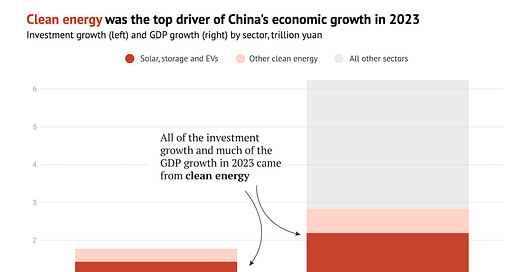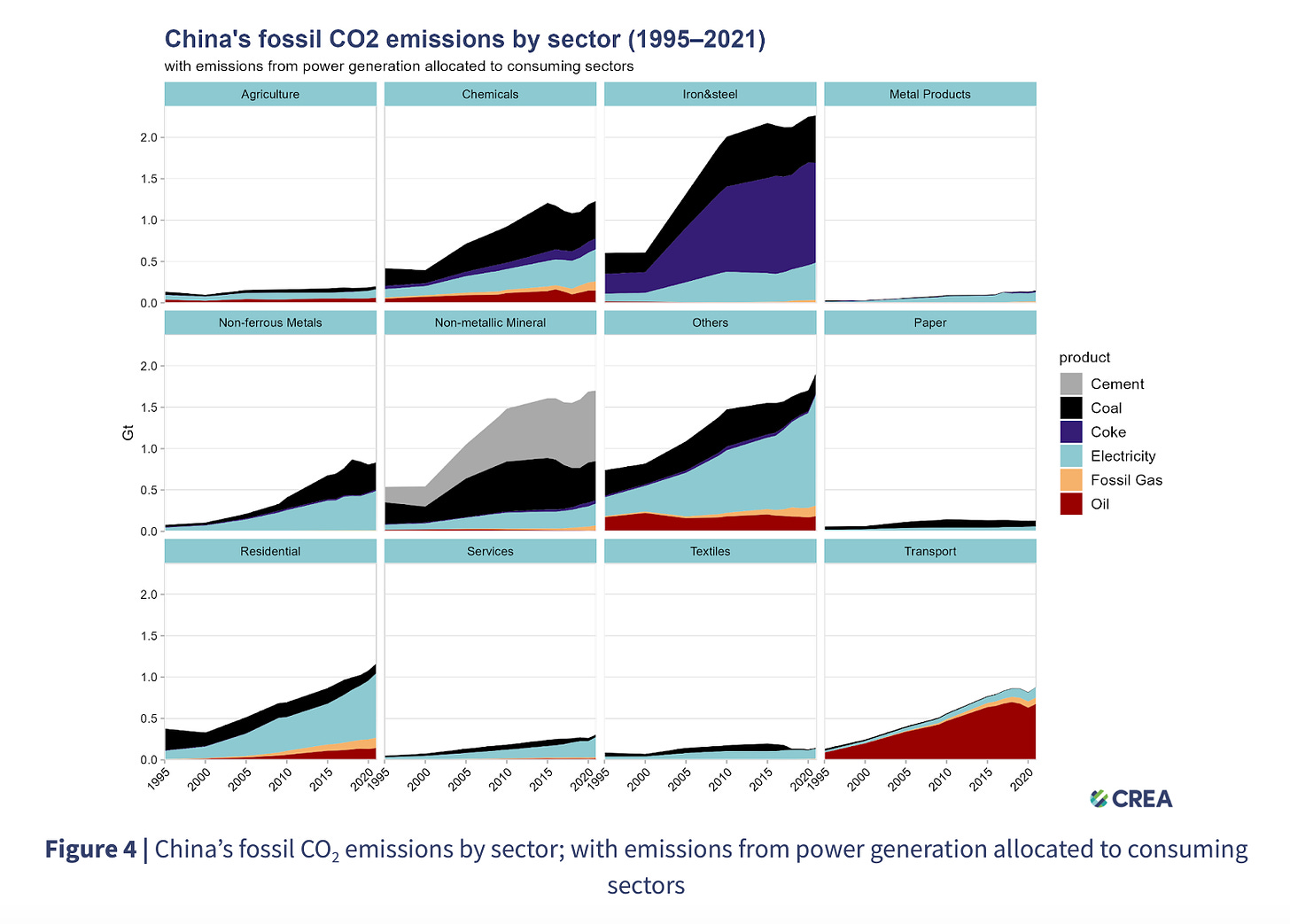Chartbook Carbon Notes 10: In China, clean energy is now THE driver of overall economic growth.
As data from the IEA confirm, the scale of China’s green energy push in the last couple of years dwarfs the much ballyhooed green energy programs in the West - NextGenEU, IRA etc.
Chinese manufacturers are expanding production of solar, wind, batteries and EV at a breakneck rate. Fierce competition is driving prices and costs down at a rate never previously imagined. Barring some unforeseen technological upset, China is set to be the leader in the first decades of the global clean energy transition.
But what is even more momentous is that China is the first large economy in which clean energy investment has become the principal driving force of overall investment and economic growth.
It is one thing for China to take on a large slice of solar panel markets. That is a global story, but a sectoral one. It is another for China’s solar energy push to take on such dimensions that it becomes one of the most important forces driving the Chinese economy, which as Chris Giles insisted in a recent piece in the FT should now be recognized by the most meaningful metrics - PPP and physical output - as by some margin the largest in the world.
In China’s energy-intensive economy, for the first time, clean energy has moved from being a niche or sectoral interest, to being the principal growth factor for the whole economy.
I highlighted this dramatic transition in Carbon Notes 6 at the end of last year, thanks to data form Carbon Brief. More detailed evidence is now to hand thanks to a powerful report from a team at CREA headed by Lauri Myllyvirta and Qi Qin, with research by Jingcheng Dai, Xinyi Shen and Chengcheng Qiu all of CREA.
The headlines are staggering.
Clean energy contributed a record 11.4tn yuan ($1.6tn) to China’s economy in 2023. Clean energy accounted for 9.0% of China’s GDP in 2023, up from 7.2% in 2022.
China’s $890bn investment in clean-energy sectors is almost as large as total global investments in fossil fuel supply in 2023
In China in 2023 green energy accounted for all of the growth in investment which was otherwise weighed down by the slump in real estate.
“Without the contribution of clean-energy sectors to China’s economic growth in 2023, the country would have seen its GDP rise by just 3.0%, instead of the 5.2% actually recorded.” Clean energy accounted for 40 percent of China’s overall economic growth, a larger share than any other sector.
As the CREA team explain:
The analysis includes solar, EVs, energy efficiency, rail, energy storage, electricity grids, wind, nuclear and hydropower within the broad category of “clean-energy sectors”. All of these are technologies and infrastructure needed to decarbonise China’s energy supply and consumption. The so-called “new three” of solar, storage and EVs are all prominent in the table – and all recorded strong growth.
The detailed breakdown shows the relative importance of each sector and the split between investment in new capacity and current production, both of which contribute to GDP.
I am not aware of any similar exercise weighing the importance of clean energy investment in the West, but back of the envelope calculation would suggest that a. the volume of green investment to date is still too modest and b. their economies less industrial so that clean energy investment will be balanced by greater investment in other sectors.
China’s lurch towards clean energy in the last few years fills the gap left by the contraction of its outsized real estate sector - perhaps better described as an urbanization-engine. Viewed from this point of view, it turns a pattern of unsustainable ultra-rapid growth in an environmentally friendly direction. That is good for the planet but makes it no more sustainable in macroeconomic terms. This may be true but it also poses the question of how relevant equilibrium considerations are in light of the climate emergency. If China is hurling resources into accelerating the energy transition should we not be applauding, profiting from and, indeed, emulating their example? Clearly this cannot mean duplicating what they are already doing. If they have stolen a huge and insurmountable lead in PV and batteries we have only ourselves to blame. They will also pay the cost in terms of overcapacity. Let us by their cheap kit and invest our scarce resources in the many other areas that demand attention. This will be the subject of another carbon note.
Harder questions are posed by the internal logic of China’s energy policy. This. is brought out by CREA’s comprehensive report on China’s climate transition for 2023.
China’s huge surge into solar is at the heart of the story. This is being driven by two main vectors. The “clean energy base” programme which involve giant solar arrays, many of them in the desert. In their case the main issue is interconnection costs. China is also a pioneer in ultra high voltage transmission, but that is an expensive option.
Source: CREA
The other main driver of growth in solar investment has been the “whole-county distributed solar” program. This has accounted for the largest share of the surge in solar investment recorded above. Together with spending on EV, charging infrastructure, railways etc, this means that a large part of China’s clean energy acceleration has so far been driven by household and consumer focuses spending. This might be thought of as analogous to China’s decision to concentrate on passenger-focused high speed rail development. It poses the question of what happens in the industrial-focused freight sector.
Residential and transport energy consumption are significant contributors to China’s giant emissions. But the pollution monsters are heavy industry.
It is the sheer size of these sectors and their vast reliance on coal that accounts for China’s huge carbon intensity of gdp.
Because it obscures these industrial realities, the macroeconomic weight of the clean energy transition in China to date, is somewhat deceptive. In China, an energy transition that addresses household and local energy needs through distributed solar and reduces oil consumption in passenger transport is a step in the right direction. But we should not confuse China’s economic structure with that in the West. In China, if the energy transition does not extend to the industrial core, it cannot substantially mitigate the pollution problem. And, on that front, the news to date is less encouraging.
For the planet it is not just the energy transition per se in China, but how fast it accomplishes it that matters. And in recent years though clean energy technologies is booming in China, overall energy and carbon emissions have been slow to turn. As the CREA report comments:
The overshoot can be attributed to rapid increases in energy demand in industry and buildings. Growth in electricity consumption in these sectors led to increases in coal use for power generation (see Figure 20). In the industrial sector, the largest increases in energy demand took place in the iron and steel, and chemical and petrochemical industries. The reason that industrial energy demand has grown faster than projected in the industrial sector is rapid growth in the output of the most energy intensive industrial sectors.
As Chinese industry shifts out of a direct use of coal towards electrification this drives a surging demand for power, which is in part met by renewables, but also creates demands for coal-fired power generation. The surge in renewables:
should already put Chinaʼs electricity sector on a pathway compatible with the global temperature goals. However, the rapid increase in power generation meant that non-fossil power generation provided only half of additional power generation in 2017–2022, with the rest provided by fossil fuels.
That spike in power demand in turn unleashed a crisis in the power sector in 2021, which I analyzed in Chartbook 64. This forced rationing to which the authorities reacted by licensing a new expansion of coal-fired capacity.
How did China go from pledging “strict control” in 2021 to a major surge in new coal projects in 2022? The turning point were concerns over electricity shortages in the autumn of 2021 and summer of 2022 which led to a policy reversal. The focus of energy policy has since shifted from discouraging and controlling new coal power projects to pushing for acceleration, with the regulators setting 85 a target in September 2022 to sharply accelerate construction starts, and pushing 86 profitable coal mining firms to invest in coal power generation. … Between January 2022 and June 2023, China permitted 152 gigawatts (GW) and started construction on 92 GW of new coal power capacity. This is eight times the amount of capacity entering construction, and more than ten times the capacity permitted, in the rest of the world during the same period. Another 25 GW, at least, was permitted in China July to September 2023
China is thus steering towards a double-crisis of overcapacity.
On the one hand the vast expansion of renewable energy capacity is unbalancing global markets. It at least is progressive and will hopefully spill over into affordable green energy solutions for the EM and developing world.
Meanwhile, at home, in the name of building reserve capacity, China has allowed a huge increase in coal-fired generating capacity for which there will be inadequate demand. Stranded assets create vested interests that will resist the energy transition in the heavy industrial core of the Chinese economy. For the global energy transition, the internal struggle within China over the future of the coal-based heavy industrial model, is a question as important if not more than that over the future of fracked oil and gas in the United States, or Russia’s destiny as an oil and gas exporter. These are the giant dominos that must tumble if we are to move rapidly along the path to decarbonization. Will the CCP regime have the courage to administer the kind of shock therapy that transformed the Chinese economy notably in the late 1990s? How will it deal with the politico-economic fallout? In terms of internal distributional consequences these questions dwarf anything faced by governments in the West.
****
Thank you for reading Chartbook Newsletter. It is rewarding to write. I love sending it out for free to readers around the world. But it takes a lot of work. What sustains the effort are voluntary subscriptions from paying supporters. If you are enjoying the newsletter and would like to join the group of supporters click below. As a token of appreciation you will receive the full Top Links emails several times per week.









Thanks for this.
Wonderful insights into the Chinese pivoting towards a green industrial policy given a flagging commercial economy. Should they become energy independent with sustainable energy, then they would be poised to export these along with battery megapacks to the rest of the world. As there are no other credible competitors, the market will belong to them. If not to Europe and the Americas, there is the Middle East who have given an ostensible interest in transitioning their energy needs towards sustainability.